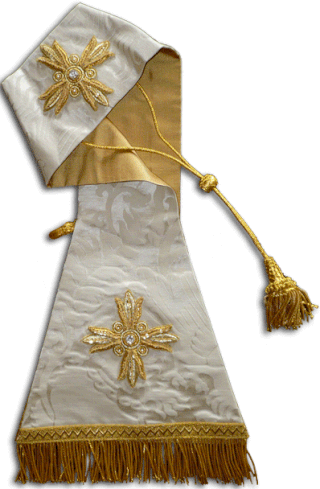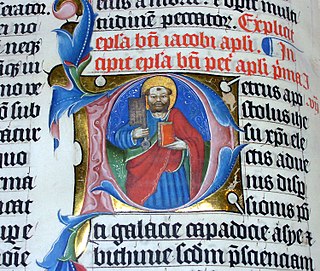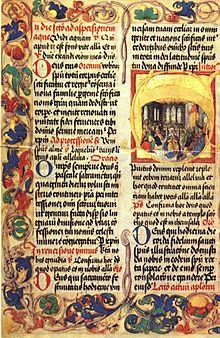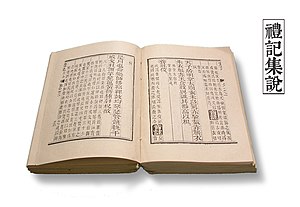
The Roman Missal is the title of several missals used in the celebration of the Roman Rite. Along with other liturgical books of the Roman Rite, the Roman Missal contains the texts and rubrics for the celebration of the most common liturgy and Mass of the Catholic Church.

Mass is the main Eucharistic liturgical service in many forms of Western Christianity. The term Mass is commonly used in the Catholic Church, Western Rite Orthodoxy, Old Catholicism, and Independent Catholicism. The term is also used in some Lutheran churches, as well as in some Anglican churches, and on rare occasion by other Protestant churches.

The Mass of Paul VI, also known as the Ordinary Form or Novus Ordo, is the most commonly used liturgy in the Catholic Church. It was promulgated by Pope Paul VI in 1969 and its liturgical books were published in 1970; those books were then revised in 1975, they were revised again by Pope John Paul II in 2000, and a third revision was published in 2002.

The Tridentine Mass, also known as the Traditional Latin Mass or the Traditional Rite, is the liturgy in the Roman Missal of the Catholic Church codified in 1570 and published thereafter with amendments up to 1962. Celebrated almost exclusively in Ecclesiastical Latin, it was the most widely used Eucharistic liturgy in the world from its issuance in 1570 until the introduction of the Mass of Paul VI.

Liturgical colours are specific colours used for vestments and hangings within the context of Christian liturgy. The symbolism of violet, blue, white, green, red, gold, black, rose and other colours may serve to underline moods appropriate to a season of the liturgical year or may highlight a special occasion.

The maniple is a liturgical vestment used primarily within the Latin Rite of the Catholic Church, and occasionally by some Anglo-Catholic and Lutheran clergy. It is an embroidered band of silk or like fabric that is hung over the left arm. It is used only during Mass, and it is always of the same liturgical colour as other Mass vestments.

Ecclesiastical Latin, also called Church Latin or Liturgical Latin, is a form of Latin developed to discuss Christian thought in Late antiquity and used in Christian liturgy, theology, and church administration to the present day, especially in the Catholic Church. It includes words from Vulgar Latin and Classical Latin re-purposed with Christian meaning. It is less stylized and rigid in form than Classical Latin, sharing vocabulary, forms, and syntax, while at the same time incorporating informal elements which had always been with the language but which were excluded by the literary authors of Classical Latin.

Rubrication is the addition of text in red ink to a manuscript for emphasis. Practitioners of rubrication, so-called rubricators or rubrishers, were specialized scribes who received text from the original scribe. Rubrication was one of several steps in the medieval process of manuscript making. The term comes from the Latin rubrīcāre, "to color red", the base word being ruber, "red". The practice began in pharaonic Egypt with scribes emphasizing important text, such as headings, new parts of a narrative, etc., on papyri with red ink.
In the liturgy of the Catholic Church, a feria is a day of the week other than Sunday.

The Introit is part of the opening of the liturgical celebration of the Eucharist for many Christian denominations. In its most complete version, it consists of an antiphon, psalm verse and Gloria Patri, which are spoken or sung at the beginning of the celebration. It is part of the proper of the liturgy: that is, the part that changes over the liturgical year.

A missal is a liturgical book containing instructions and texts necessary for the celebration of Mass throughout the liturgical year. Versions differ across liturgical tradition, period, and purpose, with some missals intended to enable a priest to celebrate Mass publicly and others for private and lay use. The texts of the most common Eucharistic liturgy in the world, the Catholic Church's Mass of Paul VI of the Roman Rite, are contained in the 1970 edition of the Roman Missal.

The Roman Rite is the most common ritual family for performing the ecclesiastical services of the Latin Church, the largest of the sui iuris particular churches that comprise the Catholic Church. The Roman Rite governs rites such as the Roman Mass and the Liturgy of the Hours as well as the manner in which sacraments and blessings are performed.
The General Instruction of the Roman Missal (GIRM)—in the Latin original, Institutio Generalis Missalis Romani (IGMR)—is the detailed document governing the celebration of Mass of the Roman Rite in what since 1969 is its normal form. Originally published in 1969 as a separate document, it is printed at the start of editions of the Roman Missal since 1970.
The International Commission on English in the Liturgy (ICEL) is a commission set up by a number of episcopal conferences of English-speaking countries for the purpose of providing English translations of the liturgical books of the Roman Rite, the originals of which are in Latin.

Pre-Tridentine Mass refers to the evolving and regional forms of the Catholic Mass in the West from antiquity to 1570.

Latin liturgical rites, or Western liturgical rites, is a large family of liturgical rites and uses of public worship employed by the Latin Church, the largest particular church sui iuris of the Catholic Church, that originated in Europe where the Latin language once dominated. Its language is now known as Ecclesiastical Latin. The most used rite is the Roman Rite.
The text and rubrics of the Roman Canon have undergone revisions over the centuries, while the canon itself has retained its essential form as arranged no later than the 7th century. The rubrics, as is customary in similar liturgical books, indicate the manner in which to carry out the celebration.

The liturgical books of the Roman Rite are the official books containing the words to be recited and the actions to be performed in the celebration of Catholic liturgy as done in Rome. The Roman Rite of the Latin or Western Church of the Catholic Church is the most widely celebrated of the scores of Catholic liturgical rites. The titles of some of these books contain the adjective "Roman", e.g. the "Roman Missal", to distinguish them from the liturgical books for the other rites of the Church.

The Kiev Missal is a seven-folio Glagolitic Old Church Slavonic canon manuscript containing parts of the Roman-rite liturgy. It is usually held to be the oldest and the most archaic Old Church Slavonic manuscript, and is dated at no later than the latter half of the 10th century. Seven parchment folios have been preserved in small format of easily portable book to be of use to missionaries on the move.
Sine populo is an expression that is used in the Roman Rite liturgy to describe a Mass celebrated by a priest without a congregation.


















